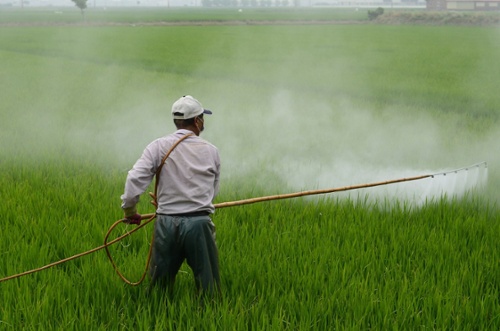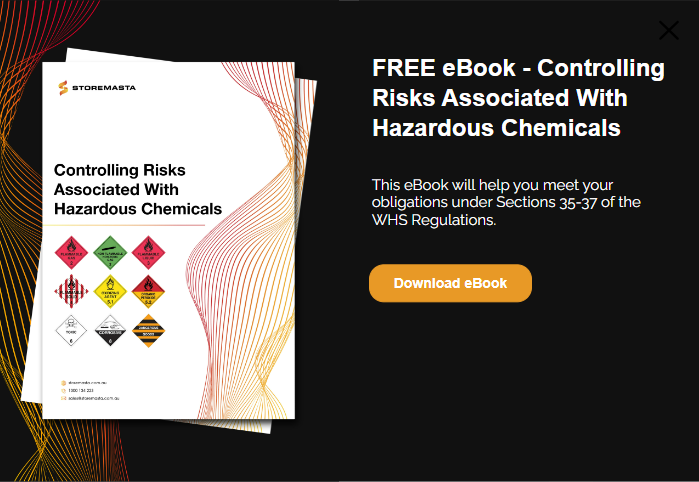Whether you’re running a large agricultural operation or a small garden maintenance business, one thing that you’ll have to consider is how to handle and store your pesticides and other agricultural chemicals. In Australia, WHS Regulations requires any workplace or organisation to provide a workplace that is free of hazards, for the safety of your people, property and the environment. However, when you’re regularly dealing with litres (or megalitres) of hazardous chemicals in your operations, it’s vital that you take all the necessary steps to protect your staff, the local community and the natural environment from these substances. In this blog, we’ll be looking at the Australian Standard that relates specifically to the storage and handling of pesticide and agricultural chemical products. We’ll also be offering some practical advice on how you can meet your chemical compliance obligations.
What Are Agricultural Chemicals?
Agricultural chemicals are defined as substances or a mixture of substances which are declared by regulation to be an agricultural chemical product. These substances include a range of products including pesticides, fertilisers, pest baits and nutritional supplements. Agricultural chemicals are generally any type of chemical that can improve the health of crops by destroying weeds, preventing pest infestations and attacks, and modifying the plant or pest to suit the required agricultural application.
Pesticides are a broad group of substances which are a key part of the agricultural chemical group. Pesticides include commonly found chemicals used including:
- Herbicides
- Insecticides
- Fungicides
- Rodenticides
- Defoliants
- Fumigants
If a chemical is classed as an approved agricultural chemical, it will be registered by the Australian Pesticides and Veterinary Medicines Authority (APVMA).
Requirements For Agricultural Chemical Storage
Pesticides and agricultural chemicals, just like any other type of dangerous goods, can create risk for the enterprises and organisations that use them.
Before you determine your storage requirements, we highly recommend conducting an onsite risk assessment so you can accurately identify and control any chemical risks that may be present. Considerations should include current usage and handling practices, decanting, pumping and spraying of chemicals, the segregation of incompatible substances and the safe storage of multiple classes of dangerous goods.
You should also determine how your operations could affect other farms, livestock, wildlife, marine life, waterways and surrounding regions if a chemical hazard did occur.
IMPORTANT: If you need assistance with an onsite risk assessment, consider contacting a Dangerous Goods Consultant or DG Specialist who can help you with your chemical compliance queries.
Minor Storage Requirements For Ag Chemicals
We’ll now look at the minor storage quantities and requirements for pesticides and agricultural chemicals in Australia. This information can be found in the Standard AS 2507:1998 – The storage and handling of agricultural and veterinary chemicals.

You may refer to the Australian Standard for detailed information on the storage of agricultural chemicals.
Our next blog in this short series will detail the requirements that apply to larger stores of agricultural chemicals. But first, let’s explain the maximum quantities for ag chemicals to be classed as minor storage.
What Are The Maximum Quantities For Minor Storage?
If you are storing smaller quantities of pesticides and ag chemicals, you should assess your site to determine if you meet the requirements for minor storage. The below information relates to the maximum quantities of agricultural chemicals that may be classed as minor storage in a particular type of storage area or building:
Areas not normally associated with dangerous goods:
| Packing Group | Liquid L | Solids kg |
| PG I | 0 | 0 |
| PG II | 5 | 5 |
| PG III and non-DG combined | 50 | 50 |
Areas where packages are opened by trained staff:
| Packing Group | Liquid L | Solids kg |
| PG I | 1 | 1 |
| PG II | 250 | 250 |
| PG III and non-DG combined | 1000 | 1000 |
Areas where packages remain closed, trained staff present within hours of operation:
| Packing Group | Liquid L | Solids kg |
| PG I | 5 | 5 |
| PG II | 250 | 250 |
| PG III in packages <210L | 1000 | 1000 |
| Non-DG | 1000 | 1000 |
*note: these tables do not include Class 4.3 chemicals
What Are The Construction Requirements For Minor Stores?
As many pesticides and agricultural chemicals are flammable or toxic, they pose a range of risks including fire, explosion, human harm and environmental contamination.

Safe storage of pesticides and agricultural chemicals will reduce serious risks such as fire.
The requirements for minor storage include provision for:
- Impermeable floor
- Liquid-tight spill containment
- Adequate ventilation (to meet workplace exposure limits)
- Protection against heat and direct sunlight
The store must also be located in a position that does not create a further hazard. This means that pesticide and agricultural chemical stores should be located:
- In a location not prone to flooding
- In any case, above the highest recorded flood level
To reduce the risk of ignition or reactions with incompatible substances, your store should also be separated from:
- Unrelated work areas, offices, amenities - by a distance of at least 3 metres
- Storage areas for gas cylinders or combustible/flammable materials or fuel storage - by a distance of at least 3 metres
- Watercourses, drains, sewers and other bodies of water - by a distance of at least 5 metres
- Other minor storage areas on the same property - by a distance of at least 100 metres (refer to the Standard for further separation requirements that relate to multiple minor storage areas)
Housekeeping of Ag Chemical Stores
Establishing and maintaining good housekeeping practices for any dangerous goods store is an important step in chemical risk reduction. AS 2507:1998 states that minor storage areas should be kept clear of residues or combustible waste materials, to reduce the risk of fire. You should also ensure that the chemicals should not be used, handled or stored in a way that could impede escape from a building in the event of an emergency.
Maintaining spill bunds is a key consideration when creating housekeeping procedures for your chemical stores. Bunded storage and chemical bunding should be immediately cleaned out after any kind of agricultural chemical leak or spill, with the hazardous waste and resulting effluent disposed of in a compliant manner. Keeping bunding free of spillage is crucial for keeping your spill capacity at a compliant and safe level.
Handling Practices
In addition to the maintenance of your agricultural chemical stores, it’s also equally important to ensure they’re being stacked and loaded correctly. Make sure that chemical containers are always fit-for-purpose, with the material suitable for the type of dangerous goods that you’re carrying. Keep containers closed when not in use and make sure that they are only opened in a well-ventilated area.
Chemical labelling is a requirement for all types of hazardous chemicals, to prevent staff from accidently using the chemical in an unsafe or ill-informed way. Any staff who are responsible for handling these chemicals, should also be made aware of the hazards associated with the product.
If you must dispense or transfer agricultural chemicals that are classed as flammable or combustible liquids, make sure that you use a self-closing safety tap to reduce the risk of hazardous vapour emissions and chemical spills. Also consider the control of static electricity during your dispensing or transferring tasks, including the installation of a hand-operated pump.
Outdoor Storage
Outdoor dangerous goods storage can offer many benefits for businesses including natural ventilation systems and larger stores. However, when it comes to the outdoor storage of agricultural chemicals, there are further requirements. We’ll go into detail about these additional requirements below:
Maximum Quantities For Outdoor Storage
Firstly, the outdoor minor storage of agricultural chemicals has a different maximum quantity as compared with indoor storage. The maximum quantities of agricultural chemicals that you can store in an outdoor chemical store is:
- PG I 10 L/kg
- PG II 500 L/kg
- PG III 3500 L/kg
Construction Requirements For Outdoor Storage
Constructions requirements for the maximum quantities detailed above include the following provisions:
- Chemicals are not intended for resale
- The area of the farm is at least 2 ha and is used for (or intended to be used for) agricultural, horticultural, floricultural or pastoral purposes
If you fall within the requirements of outdoor minor storage, you must also:
- Keep the ground around the chemical store free from combustible vegetation or refuse by a distance of at least 3 metres
- The ag chemical store must be separated from any dwelling or protected place on the property by a distance of at least 10 metres
- It must also be separated from the property boundary by at least 15 metres
- Chemical spills must be prevented from reaching protected places, property boundaries or watercourses
The location of your store — whether it's a toxic substances storage container or any type of DG store — is a key factor in maintaining safety and compliance. By following the requirements for the location of your outdoor minor store, you are protecting your enterprise, the environment and your community from the hazards associated with your agricultural chemicals.
How Are Your Storing Your Pesticides and Agricultural Chemicals?
Whether you’re storing pesticides and agricultural chemicals in a dedicated pesticide cabinet or a toxic substance store, you must follow the requirements of the Australian Standard to create a safe working environment that is free from chemical hazards. As we’ve explained in this blog, flammable or toxic chemicals can cause serious risk for agricultural and farming enterprises, including damage to property, vehicles, crops, livestock and water sources.
To find out more about maintaining chemical compliance, why not read our helpful eBook? Controlling Risks Associated With Hazardous Chemicals is written in a practical and easy-to-understand manner, so you can determine how to control risks in your agricultural enterprise. Get your free copy today to learn how to reduce chemical risk in your operations.
Joining the team as a Dangerous Goods Storage Consultant, Melissa Hampton became Storemasta's Marketing Manager in late 2021. With extensive knowledge and experience in chemical compliance, Melissa is responsible for leading the Marketing team and helping shape their marketing strategy. In her spare time, you can find Melissa hiking, swimming and enjoying the great outdoors in beautiful north-west Tasmania.

